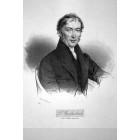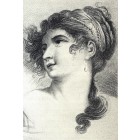The oldest written record
of Blansko comes from the Chronicle by Cosmas’s successor the Canon of Vyšehrad and dates back to 1136, when a fierce property and, most importantly, political dispute broke out between Bishop of Olomouc Jindřich Zdík and appanage Prince Vratislav of Brno regarding the right to build a church in Blansko. The dispute was finally resolved by Duke Soběslav of Prague, who sided with the bishop, allowing Zdík to complete and consecrate Saint Martin’s Church in Blansko.
The most astonishing story
connected with the history of the town is undoubtedly the story of a woman who could have become Queen of England. The story is commemorated to this day by the royal tomb surrounded by a rosarium that can be found by Saint Martin’s Church. Baroness Caroline Meineke (1768–1815), the first wife of King of England William IV, whose tumultuous, almost unbelievable but true destiny in life came to a close in Blansko, was buried here two centuries ago.
The most valuable bell in town
is called Poledník (Meridian) and is found in the tower of Saint Martin’s Church in Blansko. The bell is of a peculiar conical shape, ornamented with merely a simple line around the edge. The inscription on the bell is, unusually, located on the convex edge of the bell and reads “O rex gloriae veni in pace!” The bell is not dated, though its shape, the location of the inscription and the type of lettering (Gothic majuscule) are all evidence of its great age, and it may be dated to the beginning of the thirteenth century. It is, therefore, one of the oldest surviving bells in Moravia.
Blansko’s most important discoveries and inventions
are without doubt the discovery of paraffin and the invention of enamel that is not damaging to the health. Paraffin comes from 1833, when it was isolated in a Blansko laboratory from beech wood and tar by chemist and industrialist Karel of Reichenbach, then manager of the Salm ironworks. The inventor of enamel Eduard Bartelmus worked in Blansko at the same time. His safe enamel soon found a use in the production of kitchenware. Today, it is hard to imagine life without enamel pans or many of the products that contain paraffin.
The most curious way
in which a building got to Blansko was evidently the case of the wooden church from the seventeenth century which was brought here in 1936 by rail from Sub-Carpathian Ukraine, where the derelict building was threatened with destruction. It was re-erected in Blansko on new stone foundations in a few months by Ruthenian labourers. Building work at its original site had lasted forty years with a number of forced intervals. The church, including its original Orthodox decoration, is now one of the most important and best-preserved monuments in the Blansko area.
The most important train
was dispatched from Blansko itself on 16 May 1945. This was Special Train no. 11 554 which brought President Edvard Beneš and his wife back from exile to their homeland on the route from Blansko to Wilson Station in Prague. Part of the train was the legendary blue saloon car made for T. G. Masaryk. The occasion is commemorated by a plaque in the hall of the railway station building.
The largest sculpture
came from the workshops of Blansko’s artistic foundrymen in 2008. It is the six-ton, 7.6 metre-high bronze statue of Milan Rastislav Štefánik which has adorned the space by the Slovak National Theatre in Bratislava since 2009.
of Blansko comes from the Chronicle by Cosmas’s successor the Canon of Vyšehrad and dates back to 1136, when a fierce property and, most importantly, political dispute broke out between Bishop of Olomouc Jindřich Zdík and appanage Prince Vratislav of Brno regarding the right to build a church in Blansko. The dispute was finally resolved by Duke Soběslav of Prague, who sided with the bishop, allowing Zdík to complete and consecrate Saint Martin’s Church in Blansko.
The most astonishing story
connected with the history of the town is undoubtedly the story of a woman who could have become Queen of England. The story is commemorated to this day by the royal tomb surrounded by a rosarium that can be found by Saint Martin’s Church. Baroness Caroline Meineke (1768–1815), the first wife of King of England William IV, whose tumultuous, almost unbelievable but true destiny in life came to a close in Blansko, was buried here two centuries ago.
The most valuable bell in town
is called Poledník (Meridian) and is found in the tower of Saint Martin’s Church in Blansko. The bell is of a peculiar conical shape, ornamented with merely a simple line around the edge. The inscription on the bell is, unusually, located on the convex edge of the bell and reads “O rex gloriae veni in pace!” The bell is not dated, though its shape, the location of the inscription and the type of lettering (Gothic majuscule) are all evidence of its great age, and it may be dated to the beginning of the thirteenth century. It is, therefore, one of the oldest surviving bells in Moravia.
Blansko’s most important discoveries and inventions
are without doubt the discovery of paraffin and the invention of enamel that is not damaging to the health. Paraffin comes from 1833, when it was isolated in a Blansko laboratory from beech wood and tar by chemist and industrialist Karel of Reichenbach, then manager of the Salm ironworks. The inventor of enamel Eduard Bartelmus worked in Blansko at the same time. His safe enamel soon found a use in the production of kitchenware. Today, it is hard to imagine life without enamel pans or many of the products that contain paraffin.
The most curious way
in which a building got to Blansko was evidently the case of the wooden church from the seventeenth century which was brought here in 1936 by rail from Sub-Carpathian Ukraine, where the derelict building was threatened with destruction. It was re-erected in Blansko on new stone foundations in a few months by Ruthenian labourers. Building work at its original site had lasted forty years with a number of forced intervals. The church, including its original Orthodox decoration, is now one of the most important and best-preserved monuments in the Blansko area.
The most important train
was dispatched from Blansko itself on 16 May 1945. This was Special Train no. 11 554 which brought President Edvard Beneš and his wife back from exile to their homeland on the route from Blansko to Wilson Station in Prague. Part of the train was the legendary blue saloon car made for T. G. Masaryk. The occasion is commemorated by a plaque in the hall of the railway station building.
The largest sculpture
came from the workshops of Blansko’s artistic foundrymen in 2008. It is the six-ton, 7.6 metre-high bronze statue of Milan Rastislav Štefánik which has adorned the space by the Slovak National Theatre in Bratislava since 2009.





